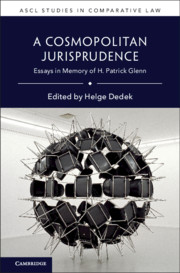Book contents
- A Cosmopolitan Jurisprudence
- ASCL Studies in Comparative Law
- A Cosmopolitan Jurisprudence
- Copyright page
- Epigraph
- Contents
- Foreword
- Acknowledgements
- Notes on Contributors
- Images
- Introduction
- Part I The Tradition of Comparative Law
- Part II The Concept of Tradition
- 6 Too Much Information
- 7 Legal Systems as Legal Traditions
- 8 Learning from Patrick Glenn: Tradition, Change, and Innovation
- 9 The Sunni Legal Tradition: An Overview of Pluralism, Formalism, and Reform
- 10 Commensurability, Comparative Law, and Confucian Legal Tradition
- Part III Crossing Boundaries
- H Patrick Glenn Publications
- Index
8 - Learning from Patrick Glenn: Tradition, Change, and Innovation
from Part II - The Concept of Tradition
Published online by Cambridge University Press: 10 December 2021
- A Cosmopolitan Jurisprudence
- ASCL Studies in Comparative Law
- A Cosmopolitan Jurisprudence
- Copyright page
- Epigraph
- Contents
- Foreword
- Acknowledgements
- Notes on Contributors
- Images
- Introduction
- Part I The Tradition of Comparative Law
- Part II The Concept of Tradition
- 6 Too Much Information
- 7 Legal Systems as Legal Traditions
- 8 Learning from Patrick Glenn: Tradition, Change, and Innovation
- 9 The Sunni Legal Tradition: An Overview of Pluralism, Formalism, and Reform
- 10 Commensurability, Comparative Law, and Confucian Legal Tradition
- Part III Crossing Boundaries
- H Patrick Glenn Publications
- Index
Summary
This chapter argues that the relationship between tradition and change can be illuminated through a better understanding of how tradition is (re)produced. How do traditions emerge, how do appeals to tradition serve to justify decisions, and, in what ways does justifying a choice in terms of tradition exercises a constraint over the kind of decision that can be made? The first part of the chapter discusses Patrick Glenn's approach to these questions, as seen, for example, in his claim that tradition is 'massaged', always entails change, and cannot control its own boundaries. It then goes on to put his ideas to the test by examining a controversial Rabbinical innovation recorded in the Talmud; Hillel's introduction of the 'Prozbul' so as to secure loans that would otherwise have been cancelled each sabbatical year. A meta-analysis of how this institution has since been categorized by those within and outside the Talmudic tradition suggests that successful innovation depends on the ability of interpreters to convince the relevant audience(s) that it embodies the best efforts to continue the tradition. It concludes that anachronism may be the price we need to pay if fidelity to tradition is to be more than antiquarianism.
Keywords
- Type
- Chapter
- Information
- A Cosmopolitan JurisprudenceEssays in Memory of H. Patrick Glenn, pp. 161 - 179Publisher: Cambridge University PressPrint publication year: 2021

